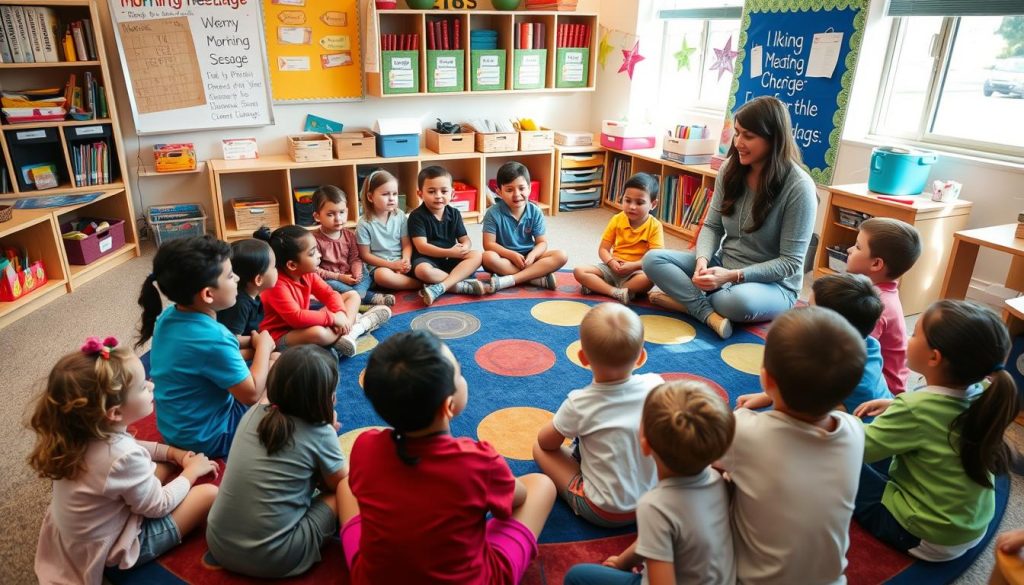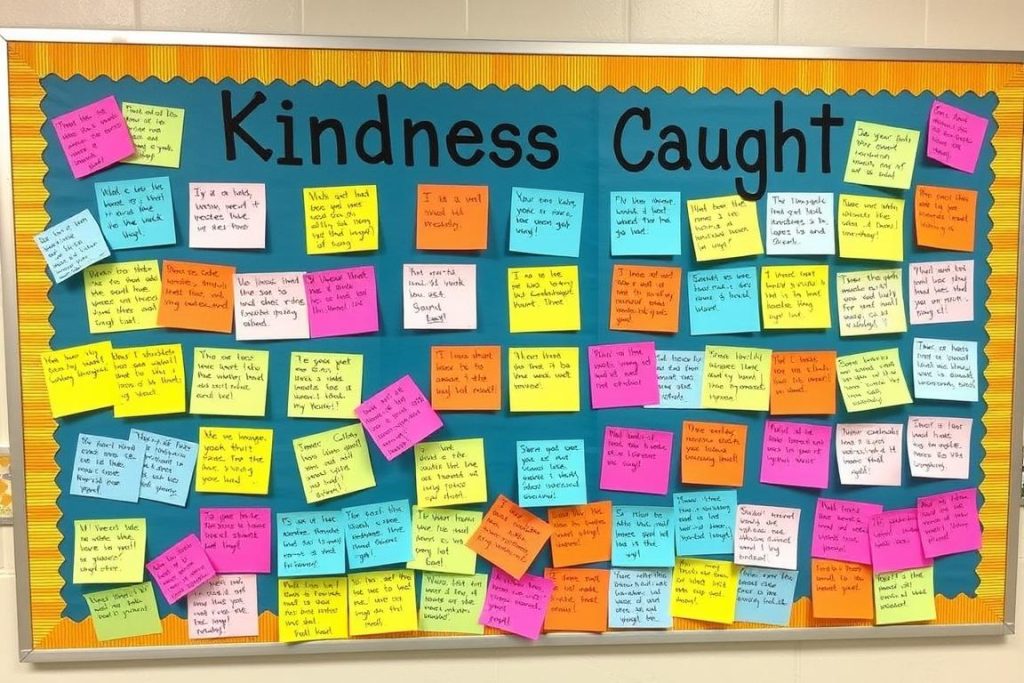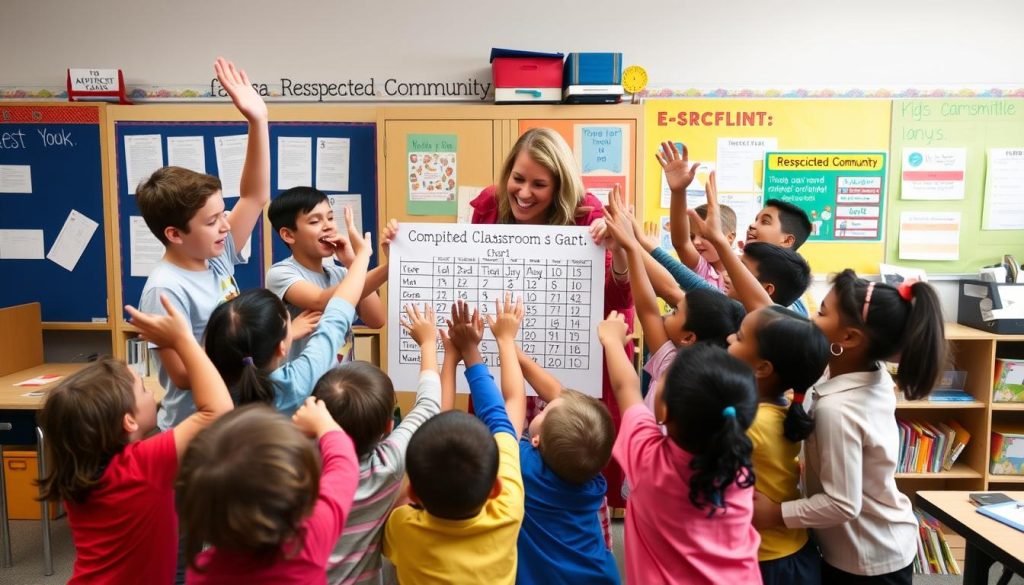Creating a circle of respect fosters meaningful classroom discussions
Why Respectful Classrooms Matter
The foundation of effective teaching begins with creating an environment where students feel safe to take risks, make mistakes, and grow. Respectful Classrooms aren’t just pleasant places to be—they’re essential for learning. According to a study by Edutopia, students in positive classroom environments show 20% higher achievement scores and significantly fewer behavioral issues.
Developing the teacher skills needed to foster respect doesn’t happen overnight. It requires intentional planning, consistent implementation, and regular reflection. When teachers prioritize creating Respectful Classrooms, they’re investing in both academic success and social-emotional development.

A well-organized classroom environment communicates respect for learning
The benefits of Respectful Classrooms extend beyond academics. Students learn crucial life skills like empathy, conflict resolution, and effective communication. These environments help children develop a positive self-concept and healthy relationships with others—skills that will serve them throughout their lives.
As you enhance your teacher skills in this area, remember that professional development opportunities can provide valuable support and fresh perspectives. Investing in your growth as an educator directly benefits your students.
Building the Foundation for Respectful Classrooms
Creating Respectful Classrooms begins with establishing clear expectations and consistent routines. Students thrive when they understand what’s expected of them and can predict how the classroom operates. Let’s explore the essential building blocks:
1. Establish Clear Expectations Together
One of the most valuable teacher skills is involving students in creating classroom expectations. When students help develop the rules, they feel ownership and are more likely to follow them. Consider these approaches:
- Hold a class meeting to brainstorm what respect looks and sounds like
- Create a classroom constitution or contract that everyone signs
- Develop 3-5 positively stated expectations (what to do versus what not to do)
- Post visual reminders of expectations throughout the classroom
- Revisit and revise expectations throughout the year as needed

Co-creating expectations builds student ownership and commitment
2. Model Respectful Behavior Consistently
Students learn more from what we do than what we say. Developing the teacher skills to consistently model respectful communication and behavior is essential. This includes:
- Using a calm, respectful tone even during challenging moments
- Demonstrating active listening when students speak
- Acknowledging mistakes and modeling appropriate apologies
- Showing respect for all students’ ideas and contributions
- Handling conflicts constructively and transparently
The Love and Logic approach emphasizes empathy first, followed by logical consequences. This powerful combination helps students learn from their mistakes while maintaining their dignity. Teachers who master these teacher skills find that students naturally begin to mirror the respectful behavior they observe.
Enhance Your Classroom Management Skills
Discover how the Love and Logic approach can transform your classroom management through practical, empathy-based strategies.
Daily Practices for Maintaining Respectful Classrooms
Creating Respectful Classrooms isn’t a one-time event—it requires consistent daily practices that reinforce your expectations and build community. These practical strategies can be implemented immediately:
1. Morning Meetings and Check-ins
Starting each day with a community-building activity helps set a positive tone. These meetings develop crucial teacher skills for facilitating meaningful discussions:
- Begin with a greeting where students acknowledge each other by name
- Include a sharing component where students can express thoughts or feelings
- Incorporate a brief group activity that promotes cooperation
- End with a message that connects to the day’s learning

Morning meetings build community and set a positive tone for learning
2. Positive Narration and Specific Praise
One powerful teacher skills technique is using positive narration—describing the positive behaviors you observe rather than focusing on negative ones. For example:
“I notice how Jamal is following directions by opening his book to page 42.”
“I appreciate how Table 3 is working collaboratively and taking turns speaking.”
This approach reinforces expectations while motivating other students to follow suit. Combine this with specific praise that acknowledges exactly what students did well, rather than generic comments like “good job.”
3. Restorative Conversations
When conflicts or behavioral issues arise, restorative conversations help maintain Respectful Classrooms. These conversations focus on repairing harm and restoring relationships rather than punishment. Key teacher skills include:
- Asking open-ended questions about what happened
- Helping students identify how their actions affected others
- Guiding students to generate solutions to repair harm
- Following up to ensure relationships are restored

Restorative conversations help students learn from conflicts
These conversations require patience and practice but are invaluable for teaching conflict resolution skills. Developing these teacher skills creates a classroom where students feel safe addressing issues directly.
Recognition Systems for Respectful Classrooms
Acknowledging and celebrating positive behaviors reinforces the culture of Respectful Classrooms. Effective recognition systems focus on intrinsic motivation while providing appropriate external acknowledgment. Here are strategies that work:
1. Class Compliments
Create opportunities for students to recognize each other’s positive behaviors. This builds teacher skills for facilitating positive peer interactions:
- Implement a “Compliment Circle” where students share positive observations about peers
- Create a “Kindness Caught” board where students and teachers can post notes about acts of kindness
- End each day with students sharing appreciations for helpful classmates

Recognition systems help students notice and appreciate positive behaviors
2. Progress Monitoring
Help students track their growth in demonstrating respectful behaviors. This develops teacher skills for meaningful assessment beyond academics:
- Create simple self-assessment tools for students to reflect on their behavior
- Use visual trackers for class goals related to respect
- Celebrate improvements and milestones as a community
The Hundreds Chart Goal described by Naomi O’Brien is an excellent example of a visual progress monitoring tool that builds community while reinforcing positive behaviors.
3. Special Roles and Responsibilities
Providing leadership opportunities helps students feel valued and develops their sense of responsibility. These teacher skills for delegation benefit both you and your students:
- Create classroom jobs that rotate regularly
- Implement a “Student of the Day” or “VIP” system
- Allow students to lead certain classroom routines or activities
Classroom jobs help students develop responsibility and ownership
These recognition systems work best when they’re consistent and accessible to all students. Developing these teacher skills creates a positive classroom culture where students feel valued and motivated.
Enhance Your Professional Development
Access resources, courses, and support to strengthen your classroom management skills and create more respectful learning environments.
Technology Tools for Supporting Respectful Classrooms
In today’s digital age, technology can be a powerful ally in creating Respectful Classrooms. These digital tools can enhance your teacher skills and provide new ways to engage students in building a positive community:
1. Digital Collaboration Platforms
Online spaces where students can work together develop important teacher skills for facilitating digital citizenship:
- Use shared documents for collaborative projects
- Create digital discussion boards where students practice respectful online communication
- Implement digital portfolios where students can showcase their work and receive peer feedback

Digital collaboration tools teach respectful online communication
2. Classroom Management Apps
Several apps can support your teacher skills for tracking and recognizing positive behaviors:
- Class Dojo for tracking and celebrating positive behaviors
- Classcraft for gamifying classroom expectations
- Seesaw for documenting and sharing student work with families
These tools provide visual feedback for students and create opportunities to recognize positive contributions to the classroom community.
3. Digital Resources for Social-Emotional Learning
Online resources can enhance your teacher skills for teaching social-emotional competencies:
- Interactive stories that teach conflict resolution
- Digital calm-down tools for self-regulation
- Video modeling of respectful behaviors

Digital tools can support students in developing self-regulation skills
As with any technology, these tools are most effective when integrated thoughtfully into your classroom routines and aligned with your expectations for Respectful Classrooms.
The Walking Classroom, mentioned by educator Taelor White-Newton, is an excellent example of how technology can support both physical activity and character development through podcasts focused on respect, kindness, and integrity.
Remember that developing the teacher skills to effectively integrate technology requires ongoing learning and adaptation. Professional development resources can help you stay current with the latest tools and approaches.
Addressing Challenges in Respectful Classrooms
Even in the most well-managed Respectful Classrooms, challenges will arise. Developing the teacher skills to address these situations effectively is crucial:
1. Persistent Behavioral Issues
When students struggle consistently with meeting expectations, consider these approaches:
- Schedule individual conferences to understand underlying needs
- Create personalized behavior plans with specific goals
- Implement check-in/check-out systems for additional support
- Collaborate with families and support staff

Individual conferences help address specific student needs
The Love and Logic approach emphasizes empathy before consequences, which is particularly effective for students with persistent behavioral challenges. This approach helps develop the teacher skills needed to maintain relationships while addressing problematic behaviors.
2. Classroom Conflicts
Conflicts between students provide opportunities to teach conflict resolution skills:
- Implement a conflict resolution protocol students can follow
- Teach and model “I” statements for expressing feelings
- Create a peace corner where students can work through disagreements
- Use role-playing to practice handling common conflicts
These strategies help students develop the skills to resolve conflicts independently, an important goal for Respectful Classrooms.
3. Transitions and Schedule Changes
Times of transition often challenge classroom respect. Develop these teacher skills to maintain order during changes:
- Create clear routines for transitions between activities
- Provide visual and auditory cues for transitions
- Prepare students in advance for schedule changes
- Practice transitions that are particularly challenging
Visual schedules help students navigate transitions successfully
Consistent routines for transitions help students feel secure and understand expectations, even during less structured times of the day.
Master Classroom Management Challenges
Learn practical strategies for addressing challenging behaviors while maintaining a respectful classroom environment.
Building Your Respectful Classroom Journey
Creating Respectful Classrooms is an ongoing journey that requires consistent effort, reflection, and adaptation. As you implement these strategies, remember that progress may be gradual, and setbacks are normal. The most important teacher skills you can develop are patience, persistence, and the ability to maintain a positive vision for your classroom community.

Celebrating community achievements reinforces respectful classroom culture
Remember that developing the teacher skills needed for Respectful Classrooms is a form of professional growth that benefits both you and your students. Continuing education opportunities can provide valuable support, fresh ideas, and connections with other educators on the same journey.
By consistently implementing the strategies outlined in this guide, you’ll create a classroom environment where students feel valued, respected, and empowered to learn. Your investment in building Respectful Classrooms will yield dividends in student achievement, behavior, and well-being for years to come.
Continue Your Professional Growth
Access resources, courses, and support to enhance your teacher skills and create even more effective learning environments.




